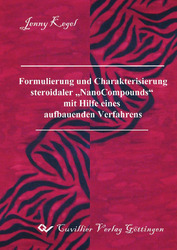| Departments | |
|---|---|
| Book Series (96) |
1378
|
| Nachhaltigkeit |
3
|
| Gesundheitswesen |
1
|
| Humanities |
2364
|
| Natural Sciences |
5406
|
| Mathematics | 229 |
| Informatics | 319 |
| Physics | 980 |
| Chemistry | 1363 |
| Geosciences | 131 |
| Human medicine | 243 |
| Stomatology | 10 |
| Veterinary medicine | 108 |
| Pharmacy | 147 |
| Biology | 835 |
| Biochemistry, molecular biology, gene technology | 121 |
| Biophysics | 25 |
| Domestic and nutritional science | 45 |
| Agricultural science | 1004 |
| Forest science | 201 |
| Horticultural science | 20 |
| Environmental research, ecology and landscape conservation | 148 |
| Engineering |
1793
|
| Common |
98
|
|
Leitlinien Unfallchirurgie
5. Auflage bestellen |
|
Advanced Search
Formulierung und Charakterisierung steroidaler ,NanoCompounds' mit Hilfe eines aufbauenden Verfahrens (English shop)
Jenny Kegel (Author)Preview
Table of Contents, Datei (59 KB)
Extract, Datei (74 KB)
Ziel dieser Arbeit war die Herstellung und Charakterisierung nanopartikulärer Arzneistoffe (‚NanoCompounds’), insbesondere steroidaler Substanzen, durch den Einsatz eines kontrollier- und reproduzierbaren Fällungsverfahrens in kleinsten Abmessungen (‚Bottom-Up-Technologie’), das gleichzeitig eine Maßstabsvergrößerung von der Laboranlage bis zum kontinuierlichen Produktionsverfahren ermöglicht. Eine durch Horn und Rieger [Horn und Rieger, 2001] aufgestellte Hypothese besagt, dass Fällungsverfahren bei geeigneter Prozessführung nicht nur die Herstellung extrem eng verteilter Dispersionen ermöglichen, sondern auch eine kontinuierliche und in den Verfahrensparametern gut steuerbare Produktionsweise erlauben. Diese wurde durch die Kombination eines Fällungsverfahrens mit einem auf der Multilamination von Flüssigkeiten basierenden Mischprinzips (Mikromischers der IMM GmbH Mainz) gestützt.
Mit Hilfe der Modellsubstanz Cholesterol wurden physiko-chemische und mechanische Prozessparameter näher betrachtet, um deren Einfluss auf den Dispersitätsgrad der erhaltenen kolloidalen Suspensionen zu identifizieren und um ein daraus resultierendes Formulierungsverfahren mit standardisierten Bedingungen zur kontrollierten und reproduzierbaren Herstellung nanopartikulärer Steroidhormone (z.B. Testosteronundecanoat, -enanthat) anzuwenden.
Neben einer effizienten Mischtechnik wurde die Einstellung einer engen Größenverteilung und die Verhinderung der Partikelagglomeration durch den entsprechenden Einsatz von bereits bekannten und darüber hinaus von neuen Stabilisatoren unterstützt, die auf der Grundlage eines neuartigen Stabilisierungskonzepts (‚Ähnlichkeitsprinzip’) zur Anwendung kamen.
Die Teilchengrößenanalyse der kolloidalen Dispersionen wurde neben bewährten Messverfahren (Dynamische Lichtstreuung, Laserdiffraktometrie etc.) durch eine bisher selten angewandte separierende und hoch auflösende Charakterisierungsmethode, der asymmetrischen Fluss Feld-Fluss-Fraktionierung (‚A4F’), vorteilhaft unterstützt und intensiviert.
Stichworte: NanoCompound, Fällung, Bottom-Up-Technologie, Präzipitation, Dispersion, Suspension, Mikromischer, Multilamination, Cholesterol, Testosteronundecanoat, Testosteronenanthat, Ähnlichkeitsprinzip, Dynamische Lichtstreuung, Laserdiffraktometrie, Asymmetrische Fluss Feld-Fluss-Fraktionierung
The aim of this thesis was the formulation and characterization of nano-particulate drugs (‘NanoCompounds’), in particular steroidal substances, through the use of a controlled and reproducible precipitation procedure in smallest dimensions (‘Bottom-Up-Technology’). This methodology allows for the extension from the laboratory scale to the continuous production. Horn and Rieger [Horn and Rieger, 2001] claim that precipitation procedures conducted during suitable processing techniques not only allow for the production of dispersions having narrow distributions, but also permit a continuous and controllable production. This should be supported through the combination of a precipitation procedure and the multilamination of liquids, which is based on the mixing principle (micro mixer of the IMM GmbH Mainz).
By the use of a model substance, namely cholesterol, the physico-chemical and mechanical process parameters were examined in detail in order to identify their influence on the polydispersity of the resulting colloidal suspensions. This, subsequently, enabled the development of a formulation procedure with standardized conditions for the controlled and reproducible production of nano-particulate steroid hormones (f.e. testosterone undecanoate, testosterone enanthate).
The study shows that the mixing technology was indeed efficient, as supported by the achievement of a narrow size distribution and the prevention of particle agglomeration through the use of known as well as novel stabilizers. These stabilizers functioned on the basis of a new stabilization concept (‘Similarity Principle’).
The particle size analysis of the colloidal dispersions was determined using common procedures (dynamic light scattering, laser diffraction etc.) and a rare separation characterization method with high resolution, namely asymmetrical flow field-flow fractionation (‘A4F’).
Catchwords: NanoCompound, precipitation, Bottom-Up-technology, dispersion, suspension, micro mixer, multilamination, cholesterol, testosterone undecanoate, testosterone enanthate, similarity principle, dynamic light scattering, laser diffraction, asymmetrical flow field-flow fractionation
| ISBN-13 (Printausgabe) | 3867270120 |
| ISBN-13 (Hard Copy) | 9783867270120 |
| ISBN-13 (eBook) | 9783736920125 |
| Language | German |
| Page Number | 232 |
| Edition | 1 |
| Volume | 0 |
| Publication Place | Göttingen |
| Place of Dissertation | Kiel |
| Publication Date | 2006-09-05 |
| General Categorization | Dissertation |
| Departments |
Pharmacy
|








